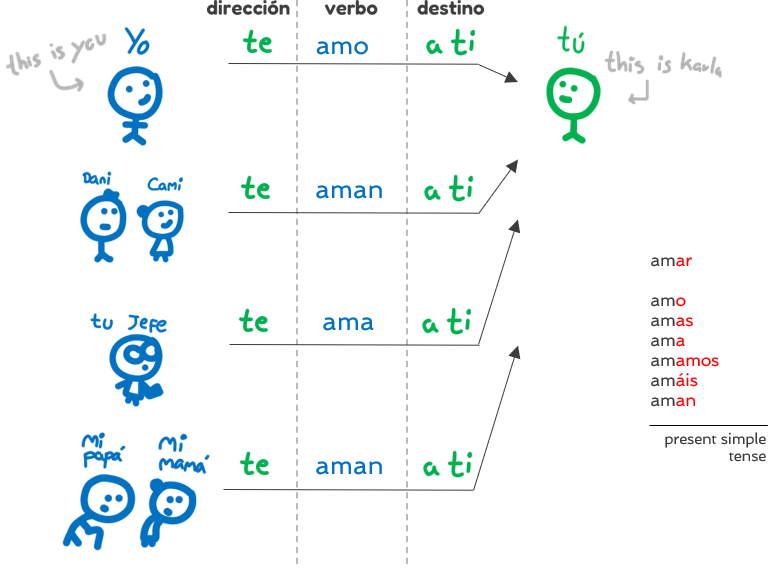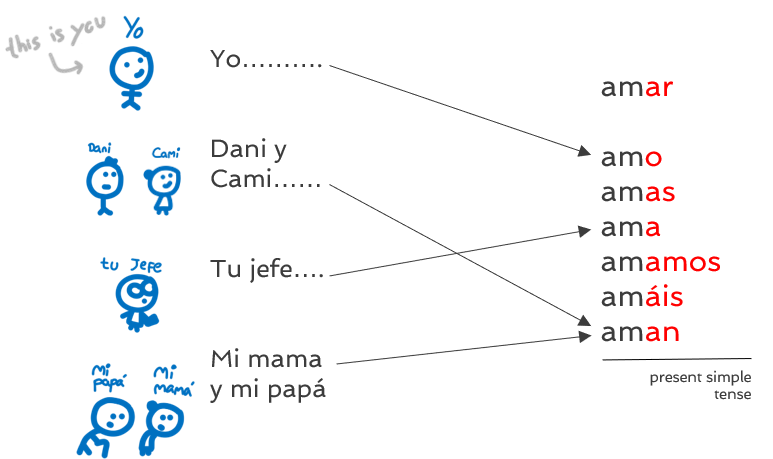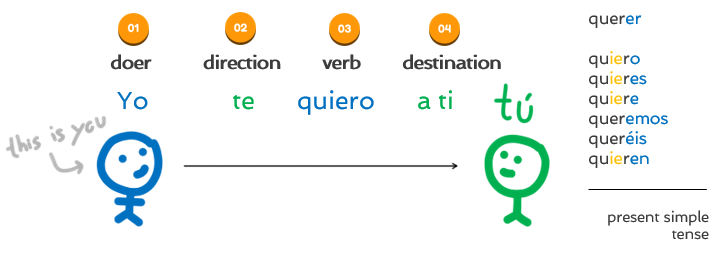Indirect object ‘te’ and ‘a ti’ in Spanish
In this guide, you will learn:
🟢 What does te amo really mean?
🟢 What ‘te’ means and how to use it correctly.
🟢 When to use ‘te’ and ‘a ti’ along with real-life examples.
🟢 What does te amo really mean?
The most basic sentence you’ve probably ever heard in Spanish is: Te amo🩷 I love you
My goal in this section is to help you finally understand why Spanish speakers sometimes speak so differently from English speakers or some other languages, by showing you what are the “enigmas” behind our way of thinking. Let me illustrate.
Indirect object ‘te’ and ‘a ti’ technical explanation
Imagine you’re talking to your sister, Karla. She’s feeling a little down, and you want to remind her how loved she is: “Hey Karla, I just wanted to tell you… I love you so much, Dani and Cami (my kids) love you, Your boss loves you, and Mom and Dad love you too”
How do you say this in Spanish?

Answer
“Yo te amo a ti mucho,
Dani y Cami te aman a ti,
tu jefe te ama a ti,
y mi mamá y mi papá te aman a ti también”
To build sentences like this, all you have to do is follow this 4-step rule—it will never make you sound weird in Spanish!
Step 1. Identify the performer of the action / doer

You have to ask yourself who is performing the action? The person who is loving.
| Yo | I |
| Dani y Cami | Dani and Cami |
| Tu jefe | Your boss |
| Mi mamá y mi papá | Mom and Dad |

Step 2. To whom is the action directed?

Identify what is the direction of the action. This is where the indirect object pronoun comes in.
‘Te’ is used here because the action is directed at Karla. (Remember, you’re talking to your sister, so Karla is “you”—the second-person singular.)
Notice how in this scenario, everyone’s action (to love) is directed at Karla:
| “I love you” | The love is directed to Karla |
| “Dani and Cami love you” | Dani and Cami are directing their love to Karla |
| “Your boss loves you” | The action of her boss is directed at Karla |
| “Mom and Dad love you” | Mom and Dad are directing their love to Karla |
So the corresponding indirect object pronoun is: ‘te’

Step 3. Identify the verb

What’s the action being performed by the doer?
Here, it’s not about who you are talking to (Karla), but about who is the doer of the action.
Conjugate the verb amar (to love) based on each doer:

Yo amo ➡️ I love
Dani y Cami ama ➡️ Dani and Cami love
Tu jefe ama ➡️ You boss loves
Mi mamá y mi papá aman ➡️ Mom and Dad love
Putting everything together, this is what we have so far up to this step:

Step 4. Identify the destination

You have to ask yourself who is the destination of the action/verb? This is also known as the indirect object.
‘A ti’ is used because the action is directed at Karla. (Again, you’re talking to your sister, so she is your “you”—second-person singular.)
Everyone´s action is directed at her.
Everyone loves her.
So, the corresponding destination is: ‘a ti’

Final result
“Hey Karla, I just wanted to tell you…
I love you so much,
Dani and Cami (my kids) love you,
Your boss loves you,
and Mom and Dad love you too”
“Ey Karla, quería decirte que
Yo te amo a ti mucho,
Dani y Cami te aman a ti,
tu jefe te ama a ti,
y mi mamá y mi papá te aman a ti también”
Common mistakes when doing the indirect object ‘te’ and ‘a ti’
You might be wondering:
What’s the difference between ‘te’ and ‘a ti’?
‘Te’ translates to you and is placed before the verb, as you saw in Step 2.
‘A ti’ can also be translated as you, but it comes after the verb, as explained in Step 4.
Don’ts
❌ Yo amo te
❌ Yo amo tú
❌ Yo amo a te
❌ Yo tu amo
Instead, try to always follow the 4-step rule you just learned. This way, you’ll start sounding more like a native and less like a robot! 😉



Still stuck in translator mode when speaking Spanish? Time to upgrade!
Our brand new course is here to help you use pronouns like me, te, nos, le, les, lo, and la with confidence — and sound way more fluent.
When to use a ti ?
❓What is the difference between yo te amo and yo te amo a ti?
Imagine you’re in a romantic story and Amelia tells you she doesn’t love Richard—she only loves you.
🔹Amelia says: “I don’t love Richard. I love you and no one else.”
🔹Amelia says: Yo no amo a Richard. Yo te amo a ti y a nadie más.
We use a ti here to emphasize that you, and not Richard, are the one she truly loves.
However, leaving it out wouldn’t change the meaning or her intention—it simply adds emotional weight and clarity to the contrast.
❓Is one more formal than the other?
No. It´s not about formality or respect.
🥳🥳🥳
Now that you’ve understood the basics of building natural and realistic sentences in Spanish using the pronouns ‘te’ and ‘a ti’, let’s go through a couple more examples to make sure this knowledge really sticks!
Example 1
How do you say I appreciate you in Spanish?

Answer
Yo te aprecio a ti | I appreciate you
Or you can simply say: te aprecio
Example 2
How do you say I love you in Spanish other than te amo?

Answer
Yo te quiero a ti | I love you
Or you can simply say: te quiero
⭐Quiz 1
Using the verb necesitar (to need), how would you say
“I need you” in Spanish?
- Check out the conjugation forms for necesitar below.
- Take a moment to think about your answer before choosing an option.
- And don’t worry if it’s trickier than you expected — that just means you’re learning!


🚀 Ready to master Spanish direct and indirect pronouns beyond this guide?
At Spanish4dinner, we’ve got you covered when it comes to mastering Spanish pronouns.

Grab your free 100 phrases you’re saying wrong 100 days to get them right eBook and start building a habit that will make your Spanish sound more natural—just like a local!